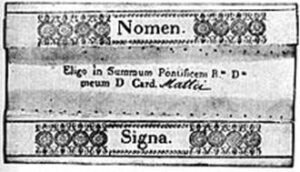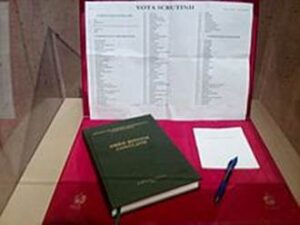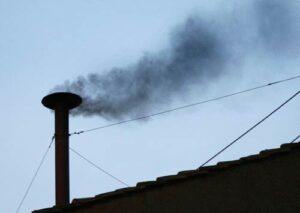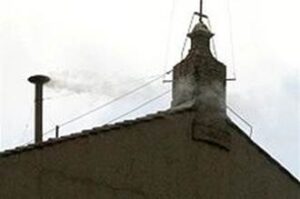Election of Pope 3
Voting

Cardinals formerly used these intricate ballot papers, one of which is shown folded above. Currently, theballots are simple cards, folded once (like a note card), with the words “I elect as Supreme Pontiff …..” printed on them.

Cardinal electors receive copies of ballot cards, scrutiny ballots, and a copy of Ordo Rituum Conclavis (Order for Rites in a Conclave). Shown above are the ballot papers of Cardinal RogerMahony used in the 2013 conclave.
On the afternoon of the first day, one ballot may be held. If a ballot takes place on the afternoon of the first day and no-one is elected, or no ballot had taken place, four ballots are held on each successive day: two in each morning and two in each afternoon. Before voting in the morning and again before voting in the afternoon, the electors take an oath to obey the rules of the conclave. If no result is obtained after three vote days of balloting, the process is suspended for a maximum of one day for prayer and an address by the senior Cardinal Deacon. After seven further ballots, the process may again be similarly suspended, with the address now being delivered by the senior Cardinal Priest. If, after another seven ballots, no result is achieved, voting is suspended once more, the address being delivered by the senior Cardinal Bishop. After a further seven ballots, there shall be a day of prayer, reflection and dialogue. In the following ballots, only the two names who received the most votes in the last ballot shall be eligible in a runoff election. However, the two people who are being voted on, if Cardinal electors, shall not themselves have the right to vote.[8]
The process of voting comprises three phases: the “pre-scrutiny”, the “scrutiny”, and the “post-scrutiny.”
Pre-scrutiny
During the pre-scrutiny, the Masters of the Ceremonies prepare ballot papers bearing the words Eligo in Summum Pontificem (“I elect as Supreme Pontiff”) and provide at least two to each cardinal elector. As the cardinals begin to write down their votes, the Secretary of the College of Cardinals, the Master of Papal Liturgical Celebrations and the Masters of Ceremonies exit; the junior Cardinal Deacon then closes the door. The junior Cardinal Deacon then draws by lot nine names; the first three become Scrutineers, the second three Infirmarii and the last three Revisers. New Scrutineers, Infirmarii and Revisers are not selected again after the first scrutiny; the same nine cardinals perform the same task for the second scrutiny. After lunch, the election resumes with the oath to obey the rules of the conclave taken anew when the cardinals again assemble in the Sistine Chapel. Nine names are chosen for new scrutineers, infirmarii, and revisers. The third scrutiny then commences, and if necessary, a fourth immediately follows.[78] No changes in these rules were made by Benedict XVI in 2007. These rules were followed, so far as is known, given the secrecy of a conclave, in electing Pope Francis in March 2013.
Scrutiny
The scrutiny phase of the election is as follows: The cardinal electors proceed, in order of precedence, to take their completed ballots (which bear only the name of the individual voted for) to the altar, where the Scrutineers stand. Before casting the ballot, each cardinal elector takes a Latin oath, which translates to: “I call as my witness Christ the Lord who will be myjudge, that my vote is given to the one who before God I think should be elected.” If any cardinal elector is in the Chapel, but cannot proceed to the altar due to infirmity, the lastScrutineer may go to him and take his ballot after the oath is recited. If any cardinal elector is by reason of infirmity confined to his room, the Infirmarii go to their rooms with ballot papers and a box. Any such sick cardinals take the oath and then complete the ballot papers. When the Infirmarii return to the Chapel, the ballots are counted to ensure that their number matches with the number of ill cardinals; thereafter, they are deposited in the appropriate receptacle. This oath is taken by all cardinals as they cast their ballots. If no one is chosen on the first scrutiny, then a second scrutiny immediately follows. A total of four scrutinies are taken each day, two in the morning and two in the afternoon.
The oath when casting one’s vote is therefore anonymous, since the name of the elector is no longer signed on the ballot with that of the candidate. (Previously, the ballot was also signed by the elector and then folded over to cover the signature of the elector and then sealed to result in a semi-secret ballot. See example above.) This was the procedure prior to 1945. Above is a copy of the old three section semi-secret ballot, which was last used in the conclave of 1939. There was no oath taken when actually casting ballots, prior to 1621.[79] Completely secret ballots (at the option of the cardinals present and voting) were sometimes used prior to 1621, but these secret ballots had no oath taken when the vote was actually cast. At some conclaves prior to 1621, the cardinals verbally voted and sometimes stood in groups to facilitate counting the votes cast. The signature of the elector covered by a folded-over part of the ballot paper was added by Gregory XV in 1621, to prevent anyone from casting the deciding vote for himself. Cardinal Pole of England refused to cast the deciding vote for himself in 1549 (and was not elected), but in 1492 Cardinal Borgia (Pope Alexander VI) did cast the deciding vote for himself.[80] Faced by the mortal challenge to the papacy emanating from Protestantism, and fearing schism due to several stormy conclaves in the late 16th and early 17th centuries, Gregory XV established this procedure to prevent any cardinal from casting the deciding vote for himself.[81] Since 1945, a cardinal can again cast the deciding vote for himself, though the 2/3 majority rule has always been continued, except when John Paul II had modified that rule in 1996 (after 33 ballots, a simple majority was sufficient), with the 2/3 majority rule restored in 2007 by Benedict XVI.[82]
Prior to 1621, the only oath taken was that of obedience to the rules of the conclave in force at that time, when the cardinals entered the conclave and the doors were locked, and each morning and afternoon as they entered the Sistine Chapel to vote. Gregory XV added the additional oath, taken when each cardinal casts his ballot, to prevent cardinals wasting time in casting “courtesy votes” and instead narrowing the number of realistic candidates for the papal throne to perhaps only two or three. Speed in electing a pope was important, and that meant using an oath so as to get the cardinals down to the serious business of electing a new pope and narrowing the number of potentially electable candidates. The reforms of Gregory XV in 1621 and reaffirmed in 1622 created the written detailed step-by-step procedure used in choosing a pope; a procedure that was essentially the same as that which was used in 2013 to elect Pope Francis. The biggest change since 1621 was the elimination of the rule that required the electors to sign their ballots resulting in the detailed voting procedure of scrutiny making use of anonymous oaths. This was perhaps the most significant change in the modern era. It was a significant change to the step-by-step voting procedure, since that detailed voting procedure was first created in 1621. It was Pius XII who made this change in 1945.[83][84]
Once all votes have been cast, the first Scrutineer chosen shakes the container, and the last Scrutineer removes and counts the ballots. If the number of ballots does not correspond to the number of cardinal electors present, the ballots are burnt, unread, and the vote is repeated. If, however, no irregularities are observed, the ballots may be opened and the votes counted. Each ballot is unfolded by the first Scrutineer; all three Scrutineers separately write down the name indicated on the ballot. The last of the Scrutineers reads the name aloud.
Once all of the ballots have been opened, the final post-scrutiny phase begins.
Post-scrutiny

Fumata nera in the Sistine Chapel, indicating that there was not a two-thirds majority in the papal election at the Conclave.[85]

Fumata bianca in Sistine Chapel, indicating that a pope has been elected by the College of Cardinals.[85]
The Scrutineers add up all of the votes, and the Revisers check the ballots and the names on the Scrutineers’ lists to ensure that no error was made. The ballots are then all burned by the Scrutineers with the assistance of the Secretary of the College and the Masters of Ceremonies. If the first scrutiny held in any given morning or afternoon does not result in an election, the cardinals proceed to the next scrutiny immediately. The papers from both scrutinies are then burned together at the end of the second scrutiny.
Fumata nera and fumata bianca
The color of the smoke indicates the results to the people assembled in St Peter’s Square. Dark smoke (fumata nera) indicates that the ballot did not result in an election, while white smoke (fumata bianca) announces that a new pope was chosen.[85] Originally, in the event a pope was not elected, damp straw was added to the fire to create dark smoke. In the event a new pope was elected, the ballots were burned alone, creating white smoke.
Prior to 1945 (when Pius XII changed the form of ballot to use anonymous oaths, first carried out in 1958), the sealing wax on the complex type ballots illustrated above had the effect of making the smoke from burning the ballots either black or white, depending on whether or not damp straw was added. This explains the confusion over the color of the smoke in the 1958 Papal conclave, caused by the lack of sealing wax on the ballots. The Siri Thesis was based on the confusion over the smoke color on the first day of that conclave.
Since 1963, chemicals have been added to the burning process, and beginning in 2005, bells ring after a successful election to augment the white smoke.[86]
During the 2013 conclave, the Vatican disclosed the chemicals used to color the smoke:[87][88][89]
· Fumata nera:
· Sulphur
· Fumata bianca:
· Lactose / milk sugar
· Colophony / pine rosin
Acceptance and proclamation
Once the election concludes, the Cardinal Dean summons the Secretary of the College of Cardinals and the Master of Papal Liturgical Celebrations into the hall. The Cardinal Dean then asks the pope-elect if he assents to the election, saying in Latin: “Acceptasne electionem de te canonice factam in Summum Pontificem? (Do you accept your canonical election as Supreme Pontiff?)” There is no requirement that the pope-elect do so and he is free to respond “Non accepto” (I don’t accept).
In practise, any cardinal who intends not to accept will explicitly state this before he receives a sufficient number of votes to become pope, asGiovanni Colombo did in October 1978.[90]
If he accepts, and is already a bishop, he immediately takes office. If he is not a bishop, however, he must be first consecrated as one before he can assume office. If a priest is elected, the Cardinal Dean consecrates him bishop; if a layman is elected, then the Cardinal Dean first ordains him deacon, then priest, and only then consecrates him as bishop. Only after becoming a bishop does the pope-elect take office. These functions of the Dean are assumed, if necessary, by the sub-Dean, and if the sub-Dean is also impeded, they are assumed by the senior cardinal-bishop in attendance. In 2005 the Dean himself—Joseph Cardinal Ratzinger—was elected pope. In 2013, the Dean and sub-Dean were not in attendance (over the age limit), and these functions were assumed by Cardinal Giovanni Battista Re.
Since 533,[citation needed] the new pope has also decided on his regnal name. Pope John II was the first to adopt a new papal name; he felt that his original name, Mercurius, was inappropriate, as it was also the name of a Roman god. In most cases, even if such considerations are absent, popes tend to choose papal names different from their baptismal names; the last pope to reign under his baptismal name was Pope Marcellus II (1555). After the newly elected pope accepts his election, the Cardinal Dean asks him about his papal name, saying in Latin: “Quo nomine vis vocari? (By what name do you wish to be called?)” After the papal name is chosen, the officials are readmitted to the conclave, and the Master of Pontifical Liturgical Ceremonies writes a document recording the acceptance and the new name of the pope.
In the past, when the cardinals were voting during the conclave, they sat on canopied thrones symbolizing the cardinals’ collective governance of the church during the period of sedevacante.[91] Upon the acceptance by the new pope of his election, all other cardinals in attendance would each pull a cord and lower the canopies above their respective thrones signifying an end to the period of collective governance and only the newly elected pope’s canopy remained unlowered.[91] The last time canopied thrones were used was during the 1963 conclave.[92] Beginning with the 1978 August conclave canopied thrones were no longer used due to the lack of space resulting from the large increase in the number of cardinal electors.
At the end of the conclave, the new pope if he so chose, would give his cardinalitial zucchetto or skull cap to the secretary of the conclave, indicating the secretary would be made cardinal at the next consistory to create cardinals. Prior to the 2013 conclave, this tradition was last followed at the 1958 conclave by the newly elected Pope John XXIII, who bestowed his cardinal’s skull cap on Alberto di Jorio and created him a cardinal at the consistory on December of that year. In 2013 the Portuguese section of Vatican Radio reported that at the conclusion of the 2013 conclave, the newly elected Pope Francis bestowed his cardinalitial zucchetto on Archbishop Lorenzo Baldisseri the secretary of that conclave[93] and on February 22, 2014 at Pope Francis’ first consistory, Baldisseri was formally made a cardinal with the title of Cardinal-Deacon of Sant’Anselmo all’Aventino.[94]
Later, the new pope goes to the “Room of Tears”, a small red room next to the Sistine Chapel; the room has the nickname because of the strong emotions experienced by the new pope. The new pope dresses by himself, choosing a set of pontifical choir robes—consisting of a white cassock,rochet, and red mozzetta—from three sizes provided. He then wears a gold corded pectoral cross, a red and gold embroidered stole, and then dons the white papal zucchetto on his head. In 2013, Pope Francis dispensed with the red mozzetta, rochet, and gold pectoral cross, wearing only the white cassock and his own pectoral cross when he appeared on the central balcony. He also did not emerge wearing the stole, vesting in it only to impart the Apostolic Blessing and removing it shortly after.
Next, the Cardinal Protodeacon (the senior Cardinal Deacon) appears at the loggia of the Basilica to proclaim the new pope. He usually proceeds with the traditional Latin formula (assuming the new Pope was a cardinal):
| Annuntio vobis gaudium magnum: Habemus Papam! Eminentissimum ac Reverendissimum Dominum, Dominum [forename], Sanctae Romanae Ecclesiae Cardinalem [surname], qui sibi nomen imposuit [papal name]. |
(“I announce to you a great joy: We have a Pope! The Most Eminent and Most Reverend Lord, Lord [forename], Cardinal of the Holy Roman Church [surname], who takes to himself the name [papal name].”) |
During the announcement for Pope Benedict XVI’s election, the cardinal protodeacon Jorge Arturo Medina Estévez greeted the crowds first in several different languages “Dear brothers and sisters” before proceeding to the Latin announcement. This was not done when Pope Francis was elected.
It has happened in the past that the Cardinal Protodeacon has himself been the person elected pope. In such an event, the announcement is made by the next senior Deacon, who has thus succeeded as Protodeacon. The last time the cardinal protodeacon was elected was in 1513 when Giovanni de Medici was elected as Pope Leo X and the next senior cardinal deacon Alessandro Farnese (the future Pope Paul III) made the announcement. During the election of Pope Leo XIII in 1878 Protodeacon Prospero Caterini appeared and started to make the announcement but was physically incapable of completing it, so another made it for him.[a]
Following the announcement, the senior Cardinal Deacon retreats, and papal aides unfurl a large, maroon banner that out of practicality often bears the late pope’s arms in the centre, draping it onto the railing of the Basilica’s loggia. During Pope Francis’ announcement, there was no image of his predecessor’s arms (indicating that the previous pope was still alive), and during Pope Pius XI‘s first appearance following his election at the 1922 conclave, the banner showed the arms of Pope Pius IX instead of the arms of his immediate predecessor Pope Benedict XV.[95] The new pope then emerges onto the balcony to the adulation of the crowd, while a brass band in the forecourt below plays the Pontifical Anthem. He then imparts theUrbi et Orbi blessing. The Pope may on this occasion choose to give the shorter episcopal blessing as his first Apostolic Blessing instead of the traditional Urbi et Orbi blessing, this happened most recently with Pope Paul VI after his election at the 1963 conclave[96] Beginning with Pope John Paul II, the last three popes elected including Pope Francis, have chosen to address the crowds first before imparting the Urbi et Orbi blessing. Also, at Pope Francis’ first appearance, he led the faithful first in prayers for his predecessor and asked them for prayers for himself before imparting the Urbi et Orbi blessing.
Formerly, the pope would later be crowned by the triregnum or Triple Tiara at the Papal Coronation. All popes since John Paul I have refused an elaborate coronation, choosing instead to have a simpler papal inauguration ceremony.[97]
Historical voting patterns
The newly elected pope often contrasts dramatically with his predecessor, a tendency expressed by the Italian saying “After a fat pope, a lean pope”. Past cardinals have often voted for someone radically different from the pope who appointed them. The controversial one-time populist-turned-conservative, long-lived Pope Pius IX (1846–1878) was succeeded by the aristocratic and diplomatic Pope Leo XIII (1878–1903). He in turn was succeeded by the lower-class, bluntly outspoken Pope Pius X (1903–1914). Pius X’s rugged ultra-conservatism contrasted with the low-key moderatism of Pope Benedict XV (1914–1922), which again contrasted with the former librarian and mountain climber Pope Pius XI (1922–1939), who led Roman Catholicism with an authoritarianism more akin to Pius X, who also shared his temperament.
Pius XI was succeeded in 1939 by his Secretary of State, the aristocratic ultra-insider Curialist Pope Pius XII (1939–1958). Pius XII was seen as one of the great thinkers to assume the papacy in the 20th century and was also the ultimate insider; his grandfather, father, cousin and brother have been Vatican high-ranking officials. Pius was succeeded by the lower-class, elderly, popular, and informal Pope John XXIII (1958–1963). The contrast between the diffident, intellectual and distant Pius XII and the humble—in his own words “ordinary”—”Good Pope John” was dramatic, with none more surprised at the election than Pope John himself. He reportedly already had his return rail ticket in his pocket when he was elected.
John proved to be a radical break with the two previous popes, and indeed with most of the popes of the 20th century. After a short but dramatic pontificate during which he convoked the Second Vatican Council, John XXIII was replaced by the widely-expected Giovanni Batista Montini, who many believed would have been elected in 1958 had he been a cardinal then. Pope Paul VI (1963–1978) was a curialist like Pius XII, whom he had worked with in the curia during the 1930s and 1940s. Paul VI himself was briefly succeeded by non-curialist Pope John Paul I (1978), who in turn was succeeded by Karol Wojtyła as Pope John Paul II (1978–2005). Wojtyła, the first non-Italian since 1523, spoke many languages and was originally from the Eastern Bloc, an important consideration given contemporary Cold War politics and the Church’s repression there. After a relatively long reign, he was succeeded in 2005 by the German Prefect of the Congregation for the Doctrine of the Faith and Cardinal Dean, Joseph Ratzinger, as Pope Benedict XVI. A more reserved and conservative pontiff than his predecessor, he reigned until his resignation in 2013, when he was succeeded by the simpler and less formal Argentinian Cardinal Archbishop of Buenos Aires Jorge Bergoglio as Pope Francis.[98]